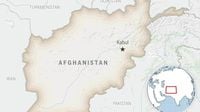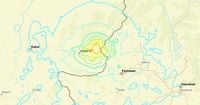Late on Sunday, August 31, 2025, a powerful 6.0-magnitude earthquake struck eastern Afghanistan near the border with Pakistan, leaving devastation in its wake. According to the U.S. Geological Survey (USGS), the quake hit at 11:47 p.m. local time, with its epicenter situated 27 kilometers (about 17 miles) northeast of Jalalabad in Nangarhar province, at a shallow depth of just 8 kilometers (5 miles). Shallow earthquakes like this are notorious for causing significant damage, especially in regions where buildings are not constructed to withstand strong tremors.
Initial reports were conflicting, with some agencies noting only minor injuries and no immediate damage. However, as the hours passed and rescue teams reached more remote areas, the grim scale of the disaster became clearer. State-run media and provincial disaster management authorities confirmed that at least 250 people had been killed and more than 500 others injured, with the toll expected to rise as rescue efforts continued. The majority of casualties were reported in the mountainous districts of Kunar province, including Nur Gul, Soki, Watpur, Manogi, and Chapadare, as detailed by The Guardian and CNN.
The earthquake was followed by at least five aftershocks, the strongest measuring 5.2 in magnitude, further complicating rescue and relief operations. A 4.5-magnitude aftershock struck just 20 minutes after the initial quake, again in Nangarhar province, as reported by AP and NBC News. The region’s steep terrain and frequent landslides made it difficult for emergency services to access the worst-hit communities, many of which are only reachable by rough mountain roads or footpaths. Landslides triggered by the quake hampered the progress of relief teams, as confirmed by the Taliban’s state-run Bakhtar News Agency.
Sharafat Zaman, a spokesperson for Afghanistan’s Public Health Ministry, told Reuters, “The number of casualties and injuries is high, but since the area is difficult to access, our teams are still on site.” He added, “We have launched a massive rescue operation and mobilized hundreds of people to help people in the affected areas.” Zabihullah Mujahid, a spokesperson for the ruling Taliban, echoed these sentiments on X (formerly Twitter), stating, “Local officials and residents are currently engaged in rescue efforts for the affected people. Support teams from the center and nearby provinces are also on their way, and all available resources will be utilized to save lives.”
The city of Jalalabad, home to around 300,000 people and a vital trade hub near the Pakistan border, felt the force of the quake. Many of its residents live in low-rise concrete or brick buildings, but the outskirts feature homes made from mud bricks and wood—structures especially vulnerable to collapse during earthquakes. Residents described scenes of panic as people rushed from their homes in the middle of the night. Ahmad Zameer, a resident of Kabul more than 100 miles from the epicenter, told CNN, “The earthquake was strong and jolted my neighborhood. Everyone from the nearby apartment buildings rushed to the street in fear of being trapped inside.”
The impact was felt beyond Afghanistan’s borders. The Pakistan Meteorological Department reported that tremors shook several cities in Pakistan’s Khyber Pakhtunkhwa and Punjab provinces, sending residents there fleeing into the streets as well. The USGS PAGER system, which predicts economic and human losses after earthquakes, issued an orange alert, warning that “significant casualties are likely and the disaster is potentially widespread. Past events with this alert level have required a regional or national level response.”
Rescue workers faced a daunting task. The mountainous terrain of eastern Afghanistan, prone to landslides and with many remote villages, challenged even the most determined efforts. Relief workers struggled to reach the most affected communities, and there were fears that the casualty count could rise as more information became available. Najibullah Hanif, the provincial information head, told The Guardian that hundreds of injured people had been taken to hospital, but figures were likely to rise as reports arrived from isolated areas with few roads.
The disaster struck a country already reeling from years of hardship. Afghanistan is one of the world’s poorest nations, battered by decades of conflict, political instability, and natural disasters. The nation sits at the intersection of the Indian and Eurasian tectonic plates, making it highly susceptible to earthquakes. The region’s vulnerability is heightened by widespread poverty, inadequate infrastructure, and a lack of resources for emergency response.
Humanitarian challenges in Afghanistan have been mounting. According to ReliefWeb, over 9.5 million Afghans—about 21% of the population—are expected to experience crisis levels of food insecurity by October 2025, driven by climatic shocks, high food prices, and funding cuts. The Famine Early Warning Systems Network, established by the United States Agency for International Development, warned last week that “below-average first and second season crop production and reduced livestock income limit their ability to stock food for the winter.” The country is also coping with the return of over 2.3 million Afghans from Iran and Pakistan this year, further straining its resources.
Afghanistan’s history is marked by deadly earthquakes. In October 2023, a magnitude 6.3 earthquake struck western Afghanistan, killing between 1,500 and 4,000 people according to estimates from the Taliban government and the United Nations. In 2022, a 5.9-magnitude earthquake claimed more than 1,000 lives in the country’s southeast. The frequency and severity of these disasters underscore the urgent need for better preparedness and international support.
As rescue and relief efforts continue, the full impact of the August 31 quake is still coming into focus. The international community watches with concern, as Afghanistan’s vulnerability to natural disasters is compounded by ongoing humanitarian crises. For the survivors, the road to recovery will be long and fraught with challenges, but the resilience of local communities and the determination of rescue teams offer a glimmer of hope amid the devastation.
The events of this week are a stark reminder of the precariousness of life in Afghanistan’s mountainous east, where the earth’s restless movements can, in an instant, upend thousands of lives. As the dust settles, the country faces the daunting task of rebuilding—not just homes and infrastructure, but also the fragile sense of security for its people.






